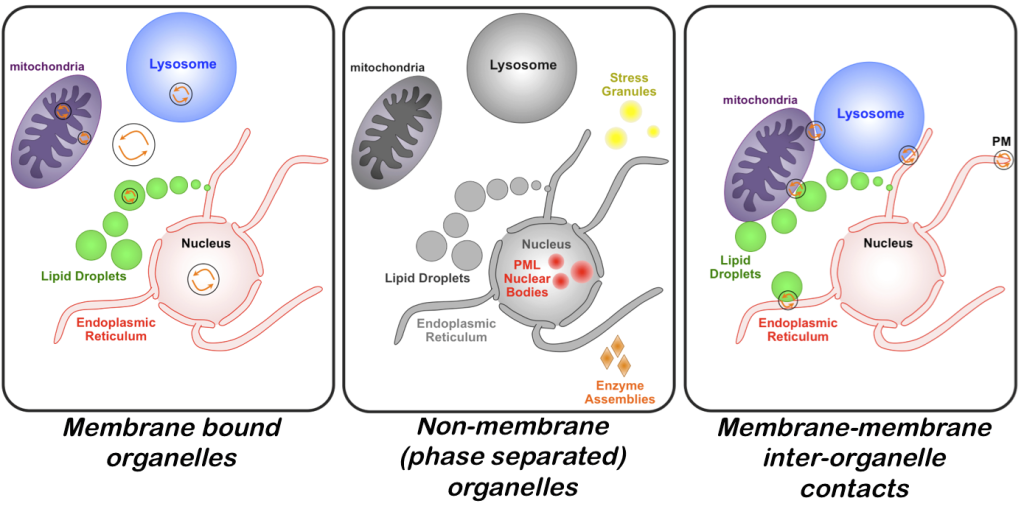
How do cells spatially organize their metabolism?
To survive in a constantly changing environment, cells must sense nutrient levels and orchestrate metabolic remodeling to respond to changes in nutrient availability. How cells coordinate an organized metabolic response to stresses such as starvation remains poorly understood.
Our lab is interested in how cells spatially organize their metabolism to adapt to a constantly changing environment. Cellular metabolism can be organized in many different ways. One of the most basic is the compartmentalization of metabolism into membrane-bound organelles. Cells also utilize non-membrane bound, or phase separated organelles such as stress bodies or cytoplasmic protein aggregates to compartmentalize specific cellular pathways under times of stress.
Our lab is interested in a third way that cells spatially organize their metabolism: at the physical junctions between organelles. These so-called inter-organelle contact sites, or membrane contact sites, serve many roles in adaptive cellular metabolism.

Cells organize lipid metabolism at lipid droplet (LD) contact sites
Our lab is deeply interested in how lipid droplets (LDs) are spatially organized within cells. One mechanism for this is by attaching LDs to other cellular compartments and thereby compartmentalizing the LDs (and their high-energy lipid stores) in distinct sub-regions of the cell interior. LDs have long been known to become attached to other organelles like mitochondria, peroxisomes, and the ER, and we have studied metabolic cues and machinery that facilitates this (Henne, EMBO, 2018; Datta, JCB, 2019; Datta, PNAS, 2020). More recently we have dissected how LDs attach to organelles like yeast lysosomes (Hariri, EMBO reports, 2017; Hariri, JCB, 2019) and the Drosophila plasma membrane (PM) of adipocytes (Ugrankar, Dev Cell, 2019). We find that all these LD-organelle contact sites promote lipid exchange between the LDs and the attached organelle, which ultimately influences cellular energy and lipid homeostasis.
Inter-organelle contacts act as "metabolic platforms" for enzymes and fine-tune metabolic pathways
Early work on ER-mitochondrial contacts indicates that inter-organelle contacts are "hotspots" for lipid synthesis enzymes (Vance, JBC, 1990). Motivated by these pioneering observations, our lab has explored how inter-organelle contacts act as metabolic platforms for the organization of enzymes in metabolic pathways. We find that yeast nucleus-vacuole junctions (NVJs) are sites of enhanced mevalonate synthesis during glucose starvation. NVJ tether Nvj1 selectively recruits the HMG-CoA Reductases (HMGCRs) Hmg1 and Hmg2 to the NVJ. Using radio-pulse labeling, we find this HMGCR spatial partitioning enhances mevalonate pathway flux and promotes metabolic adaptation for yeast facing glucose restriction (Rogers, eLife, 2021).
Lipids within lipid droplets exhibit phase transition properties
Our work on organelle organization has motivated us to understand how lipids within lipid droplets (LDs) are organized. Past studies have indicated that lipids such as sterol-esters can sometimes undergo phase transitions in LDs, giving rise to liquid-crystalline lattices within the LD interior (Mahamid, PNAS, 2019). The metabolic cues governing this have been unclear. We find that in yeast, glucose restriction can promote sterol-esters to transition into a liquid-crystalline lattice (LCL) phase (Rogers, BioRvix, 2021). The formation of LCL-LDs requires triglyceride lipolysis, which helps sterol-esters transition from a disordered to a liquid-crystalline phase. The harvesting of these triglycerides also promotes fatty acid oxidation in peroxisomes to help the yeast survive glucose restriction. We also find that LCL formation alters the LD proteome, causing some proteins to de-localize from LCL-LDs whereas others remain LD associated.
Organelle contacts influence cellular decision making
Finally, we have explored how inter-organelle contacts influence cellular decision-making. Partnering with Dr. N. Ezgi Wood, we discovered that yeast NVJ expansion is highly predictive of cellular behavior following glucose starvation (Wood, Cell Reports, 2020). Specifically, we find that yeast exposed to acute glucose removal becomes either quiescent or senescent. Yeast which expands their NVJs is much more likely to become quiescent and resume budding following glucose replenishment, whereas senescent yeast with small NVJs fails to resume growth even with glucose replenishment. Our work also points to numerous other metabolic factors that contribute to this cellular decision.